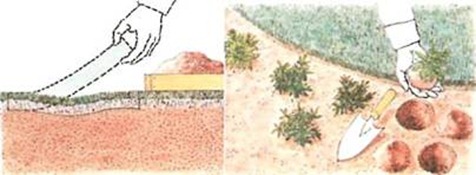





This is one of those rare fortnights when you have a lot you could learn, but relatively little that you actually need to do; so make the most of it. We show you how to plant gladiolus – a typical corm, plus telling you something of its curious natural history. We remind you how to stake your dahlias. Then back to the lawn. Lawns need constant attention, no matter how well you make them in the first place. We look at filling hollows and flattening bumps in your lawn.
Needs list: 1 bag organic garden manure; 25 gladioli corms; ½ cwt/50 lb bag soilless growing mix; 12 French marigold plants; twelve 3 ft canes; 1 pkt plant ties.
Time budget: 2 hours in 2 weeks
Many plants are already past their best, though there are plenty still to come. Many of those already over will come again if you cut them back, liquid feed and water lavishly. Still 3 months to go before frosts, and the soil is warm enough for rapid seed germination – worth a try.
Dahlias are one of the most spectacular and diverse of all groups of garden plants. There are different sorts that grow from 9 in. to 10 ft. high, and come with flowers anything from 1 in. to 12 in. across, with petals spiked, rounded, fluted scalloped and many more – single or double. What’s more there’s every colour in the rose rainbow – except true blue. No wonder people became dahlia buffs! The surprise-is that they’re not modern plants but natives of Mexico. The basic breeding was done by the Aztecs, who held them sacred. Coming from Mexico, they’re frost tender: plant in spring, lift in fall: store in dry peat or sand boxes over winter. Start with the bushy, 3 ft. pom-pom types.

By now you should have a good idea of whether or not your battle against the weeds is being successful. Check on the methods shown in Stage 4. If you really resent weeds because they look untidy rather than because they may be unduly harming your plants, you may find hard weeding is the only satisfactory solution. But you’ll know by the end of the summer just how much – or how little – of your garden you can take care of in this way.
There are chemical methods of controlling weeds, and both these and the chemicals you may want to use for killing bugs are discussed elsewhere. In general, the less chemicals you use in your garden the better. Without being fanatical about it, it is just worth remembering that most of the chemicals now sold for killing weeds or bugs were originally developed as nerve gases to kill humans: so treat them with the respect they deserve. Learn some more friends and foes: spiders are friends, eat your enemies for you: worms aerate soil, help soil breathe. All caterpillars are enemies: they eat your plants.
Gladioli, often known as sword lilies – though they are not lilies at all -are among the most spectacular of high to late summer-flowering plants. The sorts usually grown are hybrids of complex parentage, crossed from mainly South African species. These are the big growing gladioli. The smaller ones, the primulinas, butterfly gladioli and so on are derived mainly from cornfield weeds from Spain southwards. All are typical corms. A corm, like a bulb, is an underground storage organ. Foodstuffs accumulated during one growing season are stored in the corm over winter, and supply the foodstuffs needed to start it into growth next year. Most gladioli are frost tender, so you need to lift them and store them in a dry, frost-free place over winter. Some are hardy. And if you leave them in the ground you’ll find they ‘walk’.
They’ll come up in a different place each year. Plant gladioli 3 to a hole, bedded on soilless growing mix and covered above with soilless growing mix. Use the same technique for all corms. For a good show dig 4 holes each 12 in. diameter and 6 in. deep.
Two ways you can stake your dahlias. Either tie in one plant per stake, or make a tripod, train 3 plants up it. Probably gives you the best massed show.
Look after your lawn. First check levels. An eye-check will do, but use a spirit level if you’re a perfectionist. To fill hollows lever up lawn gently with a spade, fill hollow with soilless growing mix, replace lawn, firm. Remove high points similarly by lifting grass, chopping height off soil, then returning grass. Hard lawns need aerating. Spike with garden fork, pressing it 3-4 in. into the lawn, in straight rows. Work across the lawn first one way then the opposite way. Or buy yourself a roller type aerator.
Two Hour Gardening Project: Stage 26 Climbing Plants and Pergolas
Two Hour Gardening Project: Stage 25 Getting To Know Your Garden
Two Hour Gardening Project: Stage 24 Propagation and Growing Herbs
Two Hour Gardening Project: Stage 23 Principles of Pruning
Two Hour Gardening Project: Stage 19 Helleborus Niger and Bug Hunting
Two Hour Gardening Project: Stage 18 Choosing Shrubs for the Garden
Copyright © www.100flowers.win Botanic Garden All Rights Reserved